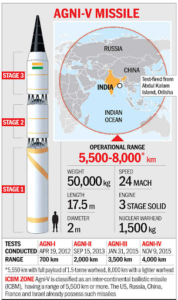In news– Recently, India successfully test-fired Agni-V, a surface-to-surface ballistic missile.
About Agni-V missile-
- Agni 5 is India’s long-range surface-to-surface ballistic missile (nuclear capable), which can hit a target with a precision that is 5,000 km away.
- It uses a three-stage solid-fuelled engine.
- The nuclear capable missile can carry a warhead of around 1,500 kg and has a launch weight of 50,000 kg, making it one of the most potent missiles in the country.
- Agni-V falls broadly in the category of an Intercontinental Ballistic Missile (ICBM).
- Though officially an ICBM needs a missile to have a range of at least 5,500 km, the Agni 5 is India’s closest contender for an ICBM.
- The initial test of the Agni-V missile was conducted in the year 2012.
- The first missile of the series, Agni-I, was developed under the Integrated Guided Missile Development Programme (IGMDP) and tested in 1989.
- Agni-1 to 5 missiles are designed and developed by the Defence Research and Development Organisation (DRDO).

Unique features of the missile-
- It is a “canisterised” missile which means that the missile can be launched from road and rail platforms, making it easier for it to be deployed and launched at a quicker pace.
- The canisterisation, which is an encapsulated system in which the missile is stored and launched from, also gives the missile a longer shelf life, protecting it from the harsher climatic conditions.
Hypersonic Glide Vehicle of China-
- China had in August tested a new hypersonic missile, which is nuclear capable.
- However, China denied the report claiming it to be a “spacecraft” and not a missile; it demonstrated the capability in hypersonic glide vehicle technology.
- A hypersonic glide vehicle is launched by a rocket which moves in the Earth’s lower orbit, at more than five times to 25 times the speed of sound.
Difference between ICBM and Hypersonic missiles-
- While an ICBM follows a parabolic trajectory, which mean it goes up and then comes down in a high arc—like when you throw up a ball, only much higher, further and faster—a hypersonic glide vehicle orbits the earth at a lower height, and is manoeuvrable.
- The ability to change track or target, mid-trajectory, along with the speed, makes them tougher to track and defend against.
- Hypersonic missiles can travel approximately at 5,000 to 25,000 km per hour, which makes them six to over 25 times faster than modern commercial aircraft.
- They fly at the heights of a few tens and 100 km.
- The mix of the high altitude, high speed and the ability to be manoeuvred makes them both challenging to the best missile defenses now envisioned and, until the last minutes of flight, unpredictable as to their targets.
- The hypersonic missile’s capability gives them both offensive and defensive advantages.
- Hypersonic technology has a dual-use character, as it can be used for non-military purposes like space launch and spacecraft retrieval.
- Apart from China, the US and Russia, Australia, Japan, and European entities are working on the Hypersonic technology.
Source: Indian Express














